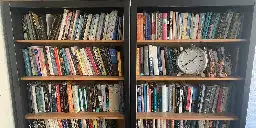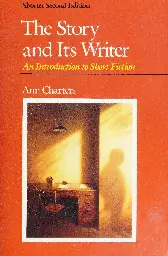-
The Story and Its Writer: An Introduction to Short Fiction - Anne Charters - 2nd Edition - Compact Version (866 pages)
cross-posted from: https://kbin.social/m/13thFloor/t/517301
> > > > > > During her many years of teaching introduction to fiction courses, Ann Charters developed an acute sense of which stories work most effectively in the classroom. She also discovered that writers, not editors, have the most interesting and useful things to say about the making and the meaning of fiction. > > > > > > > > Accordingly, her choice of fiction in the first edition of her The Story and Its Writer was as notable for its student appeal as it was for its quality and range. And to complement these stories, she introduced a lasting innovation: an array of the writers' own commentaries on the craft and traditions of the short story. > > > > > > > > In subsequent editions her sense of what works was confirmed as the book evolved into the most comprehensive, diverse-- and bestselling -- introduction to fiction anthology. Instructors rely on Ann Charters' ability to assemble an authoritative and teachable anthology, and anticipate each edition's selection of new writers and stories. > > > > > > --- > > This is the (somewhat) abridged version of the 2nd edition in PDF format. This book is a staple of creative writing courses, and is provided here for the benefit of starving students. > > There are many other editions and file formats available over at Anna's pirate cantina if you're looking for the one your professor is teaching from.
-
Open Culture - Free Cultural and Educational Media on the Web.
cross-posted from: https://kbin.social/m/13thFloor/t/302450
> Discover thousands of free online courses, audio books, movies, textbooks, eBooks, language lessons, and more.
-
Free resources for writers from the UK's National Centre for Writing
nationalcentreforwriting.org.uk Welcome to the National Centre for WritingNational Centre for Writing is a contemporary literature house in the heart of England’s first UNESCO City of Literature, committed to the transformative power of stories for personal, social and community development.

cross-posted from: https://kbin.social/m/13thFloor/t/269165
> Free guides, podcasts and interviews about writing. Featuring Margaret Atwood, Nicci French, Tim Clare, Elizabeth Haynes, Mark Dawson, Joanna Penn and more!
-
On Writing: A Memoir Of The Craft - Stephen King - 2000


cross-posted from: https://kbin.social/m/13thFloor/t/485321
> > > > > > In the early nineties (it might have been 1992, but it’s hard to remember when you’re having a good time) I joined a rock-and-roll band composed mostly of writers. The Rock Bottom Remainders were the brainchild of Kathi Kamen Goldmark, a book publicist and musician from San Francisco. The group included Dave Barry on lead guitar, Ridley Pearson on bass, Barbara Kingsolver on keyboards, Robert Fulghum on mandolin, and me on rhythm guitar. There was also a trio of “chick singers,” à la the Dixie Cups, made up (usually) of Kathi, Tad Bartimus, and Amy Tan. > > > > > > > > The group was intended as a one-shot deal—we would play two shows at the American Booksellers Convention, get a few laughs, recapture our misspent youth for three or four hours, then go our separate ways. > > > > > > > > It didn’t happen that way, because the group never quite broke up. We found that we liked playing together too much to quit, and with a couple of “ringer” musicians on sax and drums (plus, in the early days, our musical guru, Al Kooper, at the heart of the group), we sounded pretty good. You’d pay to hear us. Not a lot, not U2 or E Street Band prices, but maybe what the oldtimers call “roadhouse money.” We took the group on tour, wrote a book about it (my wife took the photos and danced whenever the spirit took her, which was quite often), and continue to play now and then, sometimes as The Remainders, sometimes as Raymond Burr’s Legs. The personnel comes and goes—columnist Mitch Albom has replaced Barbara on keyboards, and Al doesn’t play with the group anymore ‘cause he and Kathi don’t get along—but the core has remained Kathi, Amy, Ridley, Dave, Mitch Albom, and me . . . . plus Josh Kelly on drums and Erasmo Paolo on sax. > > > > > > > > We do it for the music, but we also do it for the companionship. We like each other, and we like having a chance to talk sometimes about the real job, the day job people are always telling us not to quit. We are writers, and we never ask one another where we get our ideas; we know we don’t know. > > > > > > > > One night while we were eating Chinese before a gig in Miami Beach, I asked Amy if there was any one question she was never asked during the Q-and-A that follows almost every writer’s talk—that question you never get to answer when you’re standing in front of a group of author-struck fans and pretending you don’t put your pants on one leg at a time like everyone else. > > > > > > > > Amy paused, thinking it over very carefully, and then said: “No one ever asks about the language.” > > > > > > > > I owe an immense debt of gratitude to her for saying that. I had been playing with the idea of writing a little book about writing for a year or more at that time, but had held back because I didn’t trust my own motivations— why did I want to write about writing? What made me think I had anything worth saying? > > > > > > > > The easy answer is that someone who has sold as many books of fiction as I have must have something worthwhile to say about writing it, but the easy answer isn’t always the truth. Colonel Sanders sold a hell of a lot of fried chicken, but I’m not sure anyone wants to know how he made it. If I was going to be presumptuous enough to tell people how to write, I felt there had to be a better reason than my popular success. Put another way, I didn’t want to write a book, even a short one like this, that would leave me feeling like either a literary gasbag or a transcendental asshole. There are enough of those books—and those writers —on the market already, thanks. > > > > > > > > But Amy was right: nobody ever asks about the language. They ask the DeLillos and the Updikes and the Styrons, but they don’t ask popular novelists. > > > > > > > > Yet many of us proles also care about the language, in our humble way, and care passionately about the art and craft of telling stories on paper. What follows is an attempt to put down, briefly and simply, how I came to the craft, what I know about it now, and how it’s done. It’s about the day job; it’s about the language. > > > > > > > > This book is dedicated to Amy Tan, who told me in a very simple and direct way that it was okay to write it. > > > > > > --- > > Posted free to Simon & Schusters mailing list a long time ago, provided here as a service to those unable to afford their own copy. > > Stephen King's website is here if you'd like to check out his new releases.
-
American Writers in Paris: Gertrude Stein and Ernest Hemingway
www.thecollector.com American Writers in Paris: Gertrude Stein & Ernest HemingwayAs members of ‘the Lost Generation,’ Gertrude Stein and Ernest Hemingway both emigrated to Paris at the beginning of the 20th century to write, each developing their own unique style.
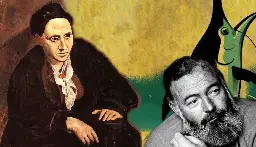
cross-posted from: https://kbin.social/m/13thFloor/t/478561
> > > > > > Gertrude Stein moved from California to Paris in 1903 with the aspiration of becoming a writer. She is best known for her art collection, plays, and novels, which involve radical experiments in language and the use of “stream-of-consciousness.” Once settled in Paris, she built up an art collection while living with her brother Leo. Stein also hosted parties and gatherings for other writers and artists and soon became a kind of matriarch and an influential advocate of the avant-garde. > > > > > > > > Ernest Hemingway arrived in Paris in 1921. Hemingway was working as a journalist at the time but also aspired to write novels. He soon came into contact with Gertrude Stein, who mentored him and encouraged him to pursue his own autobiographical writing, aside from journalism. > > > > > > > > Gertrude Stein: Literary Experiments > > > > > > > > American writer Gertrude Stein was born in Pittsburgh, Pennsylvania in 1874 and grew up in California. When she moved to Paris, she primarily began writing novels but soon became an art collector and an influential supporter of emerging art movements. To support the development of new movements and styles, Stein often mentored other writers and artists. She developed her own idiosyncratic writing style, which often involved repetition, humor, and the disruption of conventional syntax. Some of her most unusual lines can be found in her poetry: > > > > > > > >
> > “Rose is a rose is a rose is a rose.” > > Sacred Emily > > > > “The change of color is likely and a difference a very little difference is prepared. Sugar is not a vegetable.” > > A Substance in a Cushion > > > >> > > > > > > > Gertrude Stein valued experimentation and the development of new forms of expression in order to break free from the past. As a student at Harvard University, she developed an interest in psychology, which she would later apply to her writing. Gertrude Stein was influenced by the theories of American psychologist William James, especially his concept of “stream-of-consciousness,” which is a kind of automatic writing that reveals an individual’s thoughts and perceptions in a flowing state. > > > > > > > > Stein was considered a difficult writer because of her complex vocabulary and her peculiar approaches to writing. Aside from her work, Gertrude Stein had a reputation as a self-confident, quick-witted, and outspoken woman who valued her own intelligence and creativity. > > > > > > > > Stein also helped launch the careers of several Cubist and Fauvist painters, including Pablo Picasso, Henri Matisse, and Juan Gris. Aligned with emerging developments in the visual arts, Stein sought in her writing to achieve an “exact description of inner and outer reality,” while the Cubists looked for “an integral truth” beyond subjective experience. Both strands of thought wanted to move away from 19th-century conventions of subjectivity and towards something closer to scientific objectivity. > > > > > > > > Gertrude Stein’s unique method of writing, taking influences from psychological “stream of consciousness” as well as the artistic avant-garde, can be seen especially in her poem A Carafe, that is a Blind Glass: > > > > > > > >> > “A kind in glass and a cousin, a spectacle and nothing strange a single hurt color and an arrangement in a system to pointing. All this and not ordinary, not unordered in not resembling. The difference is spreading.” > > > >> > > > > > > > The Lost Generation in Paris > > > > > > > > “The Lost Generation” was a term adopted by Gertrude Stein to refer to the dispirited generation of people who had lost sons, brothers, husbands, and fathers in the First World War. However, it also encompassed more broadly those who felt displaced or disillusioned following the War, which included many American writers and artists who had emigrated to Paris in the 1920s. According to Stein, the term une generation perdue was used by a French mechanic who fixed Stein’s car while she was staying at Belley’s Hotel Pernollet in Paris. The French chef and hotelier, Monsieur Pernollet, later used the phrase, which Stein overheard and then adopted for her own writing. > > > > > > > > For Stein, the Lost Generation characterized an entire generation of people who had suffered the consequences of a global war and who had not had the opportunity to be “civilized.” The term was essentially a compassionate description, not only referring to the young men who had died fighting in the First World War but to those who had to forge a way forward in the bloody aftermath. > > > > > > > > Along with many other expatriates who had arrived in Paris from elsewhere in the first few decades of the 20th century, Gertrude Stein and Ernest Hemingway were in good company. Other members of the Lost Generation transplanted in Paris included many writers and painters, such as F. Scott Fitzgerald, Sherwood Anderson, and Pablo Picasso. > > > > > > > > Gertrude Stein’s Parisian Salon: 27 Rue de Fleurus > > > > > > > > In Paris, Gertrude Stein lived at 27 Rue de Fleurus on the Left Bank, and it soon became a social hub for emerging avant-garde painters, writers, and artists. Stein lived there with her brother Leo, and together they established an art collection and organized many soirées. She hosted a salon where artists and writers could meet, socialize, and exchange ideas while perusing her art collection. Some of the art movements Stein influenced and was directly involved with include Cubism, Fauvism, Modernism, and Primitivism. > > > > > > > > Throughout much of her early career, Stein’s writing was not commercially successful, and critics dismissed her as being incomprehensible. However, her work and her role as benefactor and mentor did capture the attention of several other American writers living in Paris at that time, which included Ernest Hemingway. > > > > > > > > Ernest Hemingway: Simple & Direct > > > > > > > > Ernest Hemingway seemed to be Gertrude Stein’s polar opposite, both in terms of writing style and in way of life. While Stein collected art and hosted soirées, Hemingway was a war veteran, a sportsman, and a journalist. However, there were similarities between the two Parisian expatriates since both had great confidence in their own abilities. When they met in Paris, Hemingway was strongly influenced by Stein’s writing. > > > > > > > > Ernest Hemingway similarly used the term Lost Generation, as an epigraph in his novel The Sun Also Rises, published in 1926. The book tells the story of expatriates who attend the running of the bulls and the bullfights in Pamplona, Spain. In the novel, Hemingway emphasizes the resilience and strength of the so-called Lost Generation, who, despite their troubles, can bounce back and can begin to live again. > > > > > > > > While Stein’s writing is playful, humorous, and experimental, Ernest Hemingway developed a simple, concise, and vigorous writing style. Moreover, his writing was colored and informed by his own lived experiences as a war veteran, a boxer, and a traveler. > > > > > > > > Ernest Hemingway was best known for his novels, though he also wrote short stories and poetry. The writer Frederick J. Hoffman describes Hemingway’s style as an “esthetic of simplicity” that concerns a “basic struggle for absolute accuracy in making words correspond to experience.” > > > > > > > > Although much of Ernest Hemingway’s work is fictional, it often draws on his own adventures and serves as an exploration of his own identity. For Hemingway, words were similar to objects in that he chose each word carefully and believed that each one served a use. He valued the utility and clarity of writing and its capacity to establish a reality based on lived, tangible experience. > > > > > > > > After leaving school, Hemingway worked as a journalist for the City Star in Kansas. It was there that he was advised to use simple, straightforward language in his articles, including brief paragraphs. The paper also advised him to “use vigorous English” and to “be positive, not negative.” He adopted these rules to his writing throughout his career and believed firmly: “the writer’s job is to tell the truth.” > > > > > > > > Allegedly, when Hemingway struggled to write, he would remind himself that writing one single true sentence would allow him to move forward. As a writer, his life and work were intimately related, and two of his most well-known novels draw on his own experiences as a First World War veteran, The Sun Also Rises and A Farewell To Arms. > > > > > > > > Ernest Hemingway Meets Gertrude Stein in Paris > > > > > > > > Despite their differences, it was inevitable that Gertrude Stein and Ernest Hemingway would come into contact. In 1921, Hemingway married Hadley Richardson and started working for The Toronto Daily Star as their European correspondent. He moved to Paris with Hadley, first settling down in a basic bare-bones apartment without running water. > > > > > > > > Before leaving Chicago for Paris, Hemingway had met Sherwood Anderson, an established American writer. Anderson had given Hemingway a letter of introduction addressed to Gertrude Stein. After meeting, Stein introduced Hemingway to the emerging art scene which she helped foster during the soirées in her salon. > > > > > > > > In Paris, Gertrude Stein guided Ernest Hemingway during his early career as a novelist and through his transition from journalism to fiction. However, their relationship was often strained and included a falling-out following the publication of The Sun Also Rises. In the end, Hemingway was deeply inspired by Stein’s writing and valued her as a mentor, though they later grew apart, each venturing their own way in the literary arts. > > > > - digitalsparkmarketing.com Unlocking Imagination: Throw Away the Rules to Succeed
Einstein once said: Logic will get you from A to B. Imagination will take you everywhere. Shows his view on the subject of unlocking imagination, doesn’t it?

cross-posted from: https://kbin.social/m/13thFloor/t/346960
> > > > > > Einstein once said: Logic will get you from A to B. Imagination will take you everywhere. Shows his view on the subject of unlocking imagination, doesn’t it? > > > > > > > > Imagination is an integral part of the human mind that covers both the creative and learning spheres. Increasing one’s imagination creates possibilities. It is considered to be the creative faculty of the mind that helps a person in process-oriented activities, such as thinking, memorizing, remembering or opinion forming. A rich imagination can enable a person to pursue and accomplish many great things. There are various ways to enrich one’s imagination how one can enrich imagination. > > > > > > > > A crucial aspect of creative thinking is the capacity to imagine. As an author and educational advisor Sir Ken Robinson once said: “Imagination is the source of every form of human achievement.” > > Without imagination, our ability to blend ideas, to see things not as they are but as they might be, is greatly hindered. If we cannot imagine new possibilities, our ability to think creatively is limited. How can we think of ways that generate novel and worthwhile ideas if we keep coming back to existing and proven ideas? > > > > > > > > To improve our imagination, we must look to the source of our perceptions: our knowledge. > > > > > > > > “Imagination will often carry us to worlds that never were. But without it, we go nowhere.” – Carl Sagan > > > > > > > > Here are 21 ways to increase imagination for better creative thinking: > > > > > > > > * Be curious > > > > > > > > Learning new things sparks creativity and increases imagination. A part of learning new things is curious. Children tend to be more imaginative because of their curious nature. Our inherent nature to seek answers or to learn new things does not disappear overage. Feed curiosity by learning and experiencing new things and notice how your imagination improves. Feed your curiosity by asking questions and build your ideas with the help of insight from others. > > > > > > > > * Collaborate with creative people > > > > > > > > Synergize your energies by spending time with people who share the same interest as yours. Brainstorming, planning, or simply talking to people will keep creative juices running, giving new and fresh ideas. > > Unlocking imagination … open your mind > > Creativity is often tagged together with originality. To come up with new ideas may be challenging and even often daunting, as unexplored paths may pose unexpected threats. It is also an avenue where one can find genuine ideas that can result in a successful endeavor. > > > > > > > > * Tell stories > > > > > > > > People love to listen to stories, and each person has a story to tell. Practice imaginative and creative thinking by telling as many stories as you can. Let it be descriptive. Let it allow you and your listener to visualize what is being told. Visualization is an important part of increasing imagination. Visualization is often perceived as one’s ability to create a clear and vivid picture in mind. This concept entails various senses as well. Visualization also involves one’s sense of touch, smell, taste, and other senses. Visualization enables you to imagine the story being told or the object being described. The more imaginative and creative the mind becomes, the more elaborate one’s visualizations can be. > > > > > > > > * Think in metaphors > > > > > > > > Thinking about problems metaphorically moves your thinking from the literal to the abstract so that you can move freely on a different plane. To a literal thinker, a rose is a rose; to a metaphorical thinker, a rose could be a young woman’s cheek, a seductive trap, or the morning sky before a storm. > > > > > > > > * Expand your interests > > Passion fuels creativity. Expand your interests by shifting your focus to include other interests that you may be passionate about. > > > > > > * Learn different things > > > > > > > > > > > > Learning sparks creativity and imagination. One’s willingness to learn new things gauges one’s ability to accept and adapt to change. It improves one’s adaptability to imaginative reasoning and creative thinking. > > > > > > > > * Find inspiration from other
businessescreators > > > > > > > > (OP's note - this was written from a marketing standpoint, so replacing "business" with "creators" to improve relevancy for our purposes). Your next idea won’t come from copying what a competitor has already done. So look for innovationinfrom differentindustries and nichescreators. > > > > > > > > * Research whatbusinessescreators are dominating. Why? > > > > > > * To whatbusinessescreator are you most loyal? Why? > > > > > > * How can you transfer what worked forbusinessescreators outside yourindustrygenre to yours? Maybe you can improve on these ideas. > > Taking inspiration from otherindustriescreators is a great way to boost your creativity. > > > > > > * Do something you love > > > > > > > > > > > > Stuck for ideas? Not sure what to do? Your life needs some balance to ensure your creativity doesn’t suffer. > > > > > > > > In a letter to his son, Albert Einstein provided a great bit of fatherly insight when addressing his son’s interest in playing the piano that applies to losing yourself in the creative process: do something that pleases you. > > > > > > > > “That is the way to learn the most, that when you are doing something with such enjoyment that you don’t notice that the time passes,” Einstein wrote. “I am sometimes so wrapped up in my work that I forget about the noon meal.” > > > > > > > > Love and creativity are intertwined. A hobby, such as playing an instrument, running, or collecting memorabilia, can help you relax and fight stress while giving your creativity a boost. > > > > > > > > * Take different perspectives > > > > > > > > At the points when you feel tired or bored, and, and you feel that your creativity is running low, look at things in a new perspective. This will give you a fresh approach to things that may even trigger new ideas that you once thought were not possible. > > > > > > > > * Try something new. > > > > > > > > It is often said that if you keep on doing the same things, then you will keep on receiving the same things. Challenge yourself to experience new things or embark on new adventures and endeavors. > > > > > > > > * Throw away preconditioned notions > > > > > > > > What is it that you have always told yourself, are you lacking in creativity or originality? Stop these thoughts; your mind is telling you things that aren’t true. Remember impermanence? Every moment is like a refresh; you are a blank canvas. Choose what you want to fill your canvas with. Tap in and experience your truest form, you are a rich, alive and buzzing and nothing will change that. > > > > > > > > * Research unknowns > > > > > > > > Always be inquisitive and most importantly listen to others without trying to form a reply. You have so much to learn from your fellow peers. Carry a Notebook and write ideas down; you might be surprised where inspiration finds you. > > > > > > > > * Carefully observe > > > > > > > > Have you noticed what’s going on around you or are you still stuck in your racing mind? Pay attention to what other successful people are doing. Talk less and listen more. > > > > > > > > * Daydream > > > > > > > > Daydreaming is more deliberate than merely dreaming, which makes it more effective in opening your mind to possibilities. Edgar Allan Poe says, “They who dream by day are cognizant of many things which escape those who dream only by night.” > > > > > > > > You can amuse yourself by speculating on these things, and it will soon become a habit. It can one day trigger an idea for a book, or for a new product that may change your life. > > > > > > > > * Play > > > > > > > > Hopscotch may not do much for your imagination, but playing games like Dungeons and Dragons or Minecraft can get you going down the path of imagination. Fortunately for you, you can legitimately play your heart out nowadays with nary a cocked eyebrow. Use it. > > > > > > > > * Creative power > > > > > > > > What can be more imagination-stirring than producing something creative? Creating something all your sparks your motivation to explore your potential further. Touch is a sense that is often underrated, but it carries a plethora of emotional responses. It excites your sense of accomplishment, making you want to go as far as you can. Seeing something take shape even as you are contemplating your next step is heady, and it will drive your imagination to new heights. > > > > > > > > * Think in pictures > > > > > > > > Many people assume Einstein was a logical, left-brain thinker, but he was the opposite. Rather than using mathematics or language to crack a tough problem, he preferred to think in pictures and spatial relationships. He recognized that visual thinking could strip a problem down to its essence, leading to profoundly simple conclusions that ordinary language might not be able to reach. > > > > > > > > * Build a bridge > > > > > > > > To build a bridge between what we know and what’s possible, we must do two things. > > > > > > > > First, we must build knowledge and gain new understandings of the world. If our minds can only imagine possibilities within the context of what we already know, then it’s clear we must increase that knowledge if we want to increase what we can imagine. > > > > > > > > Thankfully, knowledge is easily gained if you dedicate even a small amount of time to it. > > > > > > > > The second thing we must do to increase our imaginations, once we have begun to build our knowledge, is to remain powerfully curious about that knowledge, even humorously so. > > > > > > > > We can do this by asking questions constantly, not only about new things we experience but about everything old and true as well. > > > > > > > > * Learn through collaboration > > > > > > > > Andrew Ng, formerly of Google and now of Baidu, is one who doesn’t believe innovation is due to unpredictable flashes of genius. Rather, he said you can become more creative and innovative systematically. > > > > > > > > “In my own life, I found that whenever I wasn’t sure what to do next, I would go and learn a lot, read a lot, talk to experts. I don’t know how the human brain works but it’s almost magical: when you read enough or talk to enough experts when you have enough inputs, new ideas start appearing.” > > > > > > > > Indeed, collaborating with and learning from others may be just what you need to give your creativity a boost. -
The Feynman Technique: Write about what you learn. It pushes you to understand topics better.
addyosmani.com Write about what you learn. It pushes you to understand topics better.Write about what you learn. It pushes you to understand topics better. Sometimes the gaps in our knowledge only become clear when explaining things to others.
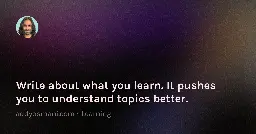
cross-posted from: https://kbin.social/m/13thFloor/t/342733
> > > > > > Writing about what you learn can deepen your understanding in several ways. It requires thoroughly exploring topics, articulating your thoughts clearly, and reflecting on connections. This process reveals gaps and inconsistencies in your knowledge. Regular writing also improves retention and communication skills long-term. The Feynman Technique promotes explaining concepts simply, which mirrors the benefits of writing explanations. Maintaining consistency is important for building habits, improving gradually, and achieving goals. While procrastination and burnout can hinder consistency, setting routines and celebrating progress can help overcome these challenges. Overall, writing about learning, using techniques like Feynman’s, and persevering consistently cultivates deeper understanding and drives lifelong curiosity and growth. > > > > > > * per @trashhalo, from their original post. Big thanks to them for bringing my attention to the article, and providing an excellent summary.
-
Kurt Vonnegut, Shape of Stories
m.youtube.com Kurt Vonnegut, Shape of Stories (subtitulos castellano)Kurt Vonnegut LectureFebruary 4, 2004The Case College Scholars ProgramSubtitles: Eva Collins Alonso
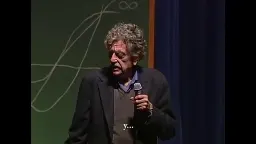
cross-posted from: https://kbin.social/m/13thFloor/t/336029
Thanks to @[email protected] for the original post.
> "If this isn't nice, I don't know what is." > > Kurt Vonnegut Lecture (February 4, 2004, The Case College Scholars Program, Subtitles: Eva Collins Alonso)
-
Looking for mods!
As I have mentioned in other places, it is not my intention to keep this magazine or others as my own. If anyone is interested in moderating and creating content for this magazine or any other I own, please let me know as soon as possible. :)
Extra points If you owned the corresponding sub back on Reddit but it is not necessary.
